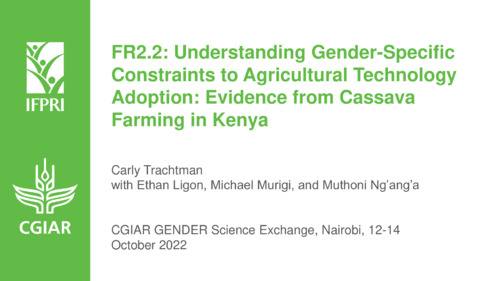FR2.2: Understanding Gender-Specific Constraints to Agricultural Technology Adoption: Evidence from Cassava Farming in Kenya
Abstract
Female subsistence farmers in developing countries often have lower levels of agricultural productivity than men, partially due to lower adoption rates of agricultural technologies. These lower adoption rates may be due to lack of physical access to new technologies or lack of access to information about new technologies, among other explanations. In this study, we consider these two classes of explanations of low technology use among females, and test the relative impacts of interventions designed to combat each. Specifically, we consider adoption of a climate-resistant, early maturing cassava variety by female farmers. Using a randomized control trial with a 2x2 matrix treatment design, we plan to test the effects on cassava adoption by female farmers of two interventions: delivering cassava seeds to female farmers at their homes (improved access), and hiring female "lead farmers," to diffuse information about cassava seeds (improved information access). Results from a small pilot in 6 villages suggest that 1) male lead farmers are less likely than female lead farmers to train female household members during a household visit (despite all lead farmers being explicitly instructed to train females), and 2) female farmers almost unanimously prefer receiving training from a female lead farmer. Pilot results also provide insights on ways that the treatments can be improved, such as lead farmers providing follow-up training visits. These preliminary findings support the viability and importance of employing female trainers in teaching female farmers about new agricultural technologies.

